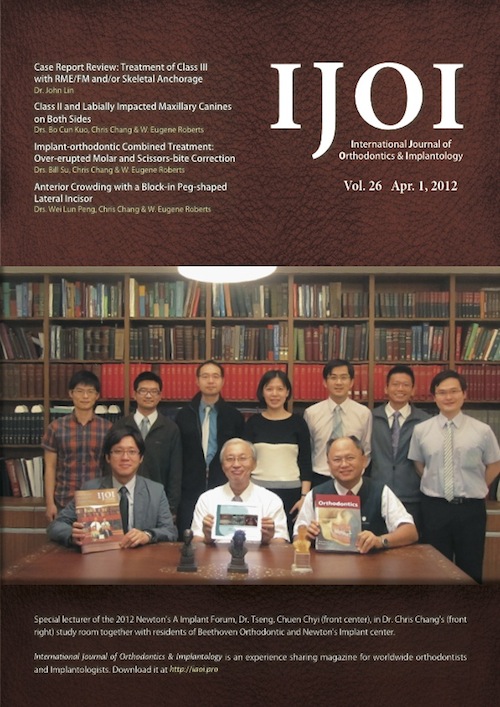IJOI Vol. 26

Case Report Review: Treatment of Class III with RME/FM and/or Skeletal Anchorage
Lin JJ
Introduction
The author was recently invited to speak at the 2012 Damon Forum on the topic of Class III treatment. In response to many comments received during the lecture as well as throughout the conference regarding the effectiveness of the Damon system for Class III treatment, the author aims to provide a literature review of case reports on Class III treatment. Personal comments are also provided for each case. The author argues that, based on extensive personal clinical experiences, patients of easy to moderate Class III conditions present no needs for complex protocols or devices, such as RME/FM, mini-plate/FM, mini-plate/mini-plate. For severe Class III cases, early treatment with RME/FM, mini-plate/FM, mini-plate/mini-plate can provide short term therapeutic effects, but the result will be compromised by further mandibular growth. So far no appliances have been proven to have sustainable effects on stopping mandibular growth later in time. On the other hand, for adult patients with an orthognathic or acceptable mild prognathic profile, the powerful light force Damon system (Fig. 2), and the combined use of buccal shelf mini-screws (Figures 1, 3), can provide satisfactory camouflage treatment results without orthognathic surgeries. (Int J Orthod Implantol 2012;26:4-16)
CIass II and Labially Impacted Maxillary Canines on Both Sides
Kuo BC, Chang CH, Roberts WE
HISTORY AND ETIOLOGY
A 12-year-1-month male was referred by his dentist for orthodontic consultation (Fig. 1). His chief concern was delayed eruption of upper canines (Figures 2, 3) and cross bite of the upper left lateral incisor. There was no other contributory medical or dental history. As documented in Figures 4-6, the patient was treated to a near ideal outcome. Before and after treatment radiographic documentation is provided in Figures 7 and 8, as well as in the cephalometrics table. (Int J Orthod Implantol 2012;26:20-33)
Implant-orthodontic Combined Treatment: Over-erupted Molar and Scissors-bite Correction
Su B, Chang CH, Roberts WE
History and Etiology
A 28-year-2-month-old male was referred for orthodontic consultation by his family dentist (Fig. 1). His chief concern was the restorative need for a missing lower molar (Figures 2, 3). A pre-prosthetic orthodontic plan was proposed. There was no contributory medical or dental history. Clinical examination revealed a Class I molar relationship on the right, but the left premolars were Class II (Figures 2, 3). The mandibular dental midline was 3 mm to the left of the facial and maxillary midlines. Cast evaluation documented the following dental problems: 1. scissors-bite over upper second molars bilaterally. 2. extrusion of the maxillary left first molar. 3. minor crowding in both arches. The patient was treated to an acceptable result as documented in Figures 4-9, as will be subsequently discussed. (Int J Orthod Implantol 2012;26:36-53)
Anterior Crowding with a Block-in Peg-shaped Lateral Incisor
Peng WL, Chang CH, Roberts WE
History and Etiology
A 15-year-8-month female came to ask for full mouth evaluation because of the crooked display of her teeth when she smiled. After intraoral examination, both arches showed anterior crowding. A palatally malposed maxillary lateral incisor was noted (Fig. 9). There was no systemic diseases and known drug allergy. Her oral hygiene was acceptable. She received operative dental treatment in the past. There was no history of dental trauma or oral habits, and no significant signs and symptoms of temporomandibular dysfunction. (Int J Orthod Implantol 2012;26:56-69)
The Close Eruption Technique for Trans-alveolar Impacted Lower 1st Premolar
Lin HY, Chang CH
Introduction
The close window technique is an ideal surgical option to treat trans-alveolar impacted premolar. This article aims to provide step-by-step illustrations on the surgical procedures that can improve safety, mechanics and healing of the wound so doctors can use them as a checklist before approaching this type of cases. (Int J Orthod Implantol 2012;26:74-80)
Restoration of the Upper and Lower Dental Arches with Monolithic Zirconia-fixed Detachable Prostheses: Clinical Report after Three Years of Use
Rojas-Vizcaya F
Summary
In the case of fixed detachable dental prostheses some problems arose for patients, dental technicians and dentists. The most frequently emerging general problem is loosening or breakage of the occlusal screws. Further problems turned out to be wear and detachment or breakage of the resin teeth from metal acrylic blends, the breakage of porcelain from metal and ceramic or zirconia and ceramic blends as well as breakage of the framework in some free-end prostheses. For this type of prosthesis it is necessary to leave the implants in a position that enables occlusal or lingual access to not impair the aesthetics.
This clinical report describes the case of a patient with a complete restoration of fixed detachable, maxillary and mandibular prostheses out of 100% zirconia (monolithic zirconia). It includes the incisal and occlusal areas on angled dental implants with buccal access and an aesthetic prosthesis solution, for which no clinical complications in the patient's mouth have been reported after 3 years. (Int J Orthod Implantol 2012;26:82-91)
Key words: Dental implants, zirconia framework, fixed detachable prosthesis, monolithic zirconia
Download Article